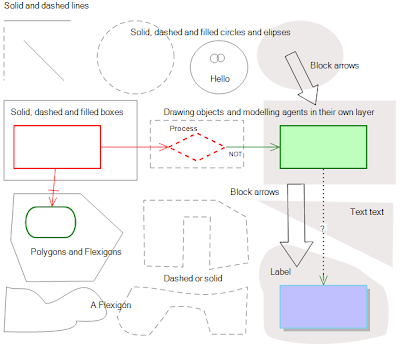This Southbeach Notation diagram illustrates some of the Southbeach Semantics in a simple model of a business. Its purpose is both to describe the situation and provide a basis from which to agree on key facts (e.g. there are insufficient sales) and priorities (e.g. marketing is the focus of attention). Southbeach models exist to support the analysis process in improving the situation. Thus, each element of a Southbeach model can provide a pivot point for improvement. Some examples are provided below.
Here is how to read this diagram:
Spending produces (arrow) materials which are used (small box end) by the manufacturing process to create (star) products which produce sales which produce revenue which produce profit. The profit is the goal (solid green box), and it is counteracted by the spending, considerd harmful and hence shown in red. Spending also produces marketing which increases the sales from the products. However, competitors (harmful) counteract the production of sales. Sales are shown as insufficient (dashed box) and marketing is the focus of attention (yellow highlight). Note the filled circle at the start of some effect lines indicating that the agent is necessary for the effect to occur, e.g. Spending is necessary to increase materials, manufacturing, and marketing.
Note the short dashed lines across some of the effects. These indicate that the effect occurs after a delay. For example, there is a delay between acquisition of the materials and use of those materials by the manufacturing process to create the product.
Here are some improvement alternatives illustrated by this diagram:
All green boxes are useful, so increasing them is likely to increase the usefulness of the overall system. Red boxes are harmful, so need to be reduced, but a balance must be struct as although spending is considered harmful, it has multiple useful effects - spending is necessary - so the reduction of spending is only useful if it can be achieved without reducing the useful products of that spending (materials, manufacturing, and marketing). Similarly, delays on useful effects are opportunities for improvement as they represent a delay in realisation of potential value held in the system. Note that competitors have no useful function in this system as they are harmful, counteract the useful production of profit, and have no useful side effects (from the perspective of the business), so finding ways to avoid, prevent, remove, or diminish the impact of competitors is worthwhile investment as long as it does not cost more than the profit (i.e. as long as the business is actually viable).
There are more subtle ways in which creativity techniques can be combined with Southbeach models. For example, the sales are insufficient. So how can we resolve that? From the model, we can spend more on marketing to increase the production of sales from products, or we can spend more on manufacturing to create more products - more kinds of products to hit more of the market, or more products to places where it is needed if the market is not uniform in its consumption. We can find ways to diminish the effect of the competitors; by selling the products where our competitor has no influence, by removing the competitor through acquisition, by branching out into markets not addressed by our competitor. We can also move into other kinds of sales than products; perhaps there is revenue to be made by providing service contracts. Combining creativity techniques of various forms with Southbeach models as a mechanism for driving a structured brainstorming approach can be a very powerful way to create improvement directions that will be more complete and more directed to where they are needed most.
The model below shows how these improvement ideas can be arrived at by working around the agents and effects in the diagram:
Blue boxes are improvement actions.






